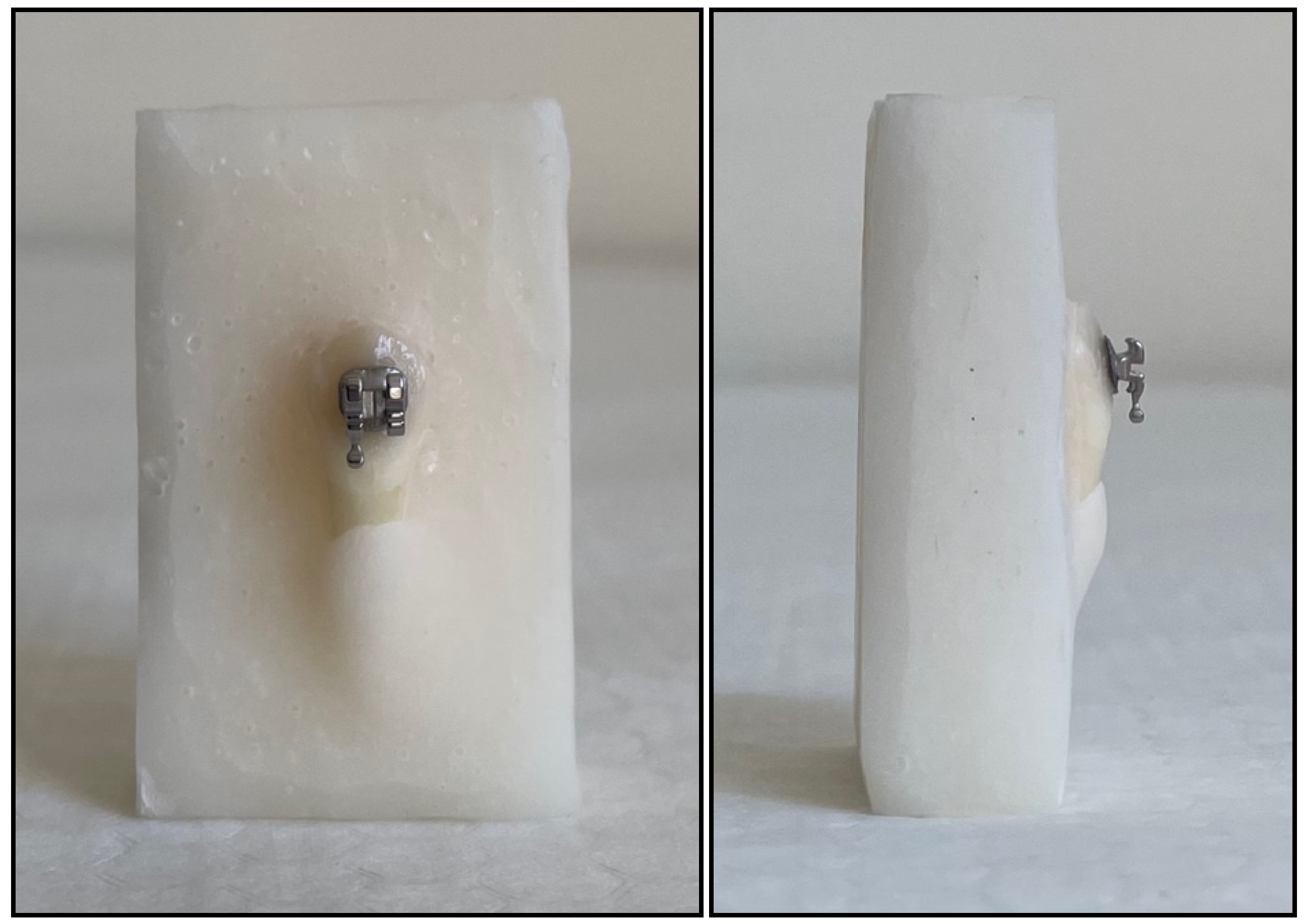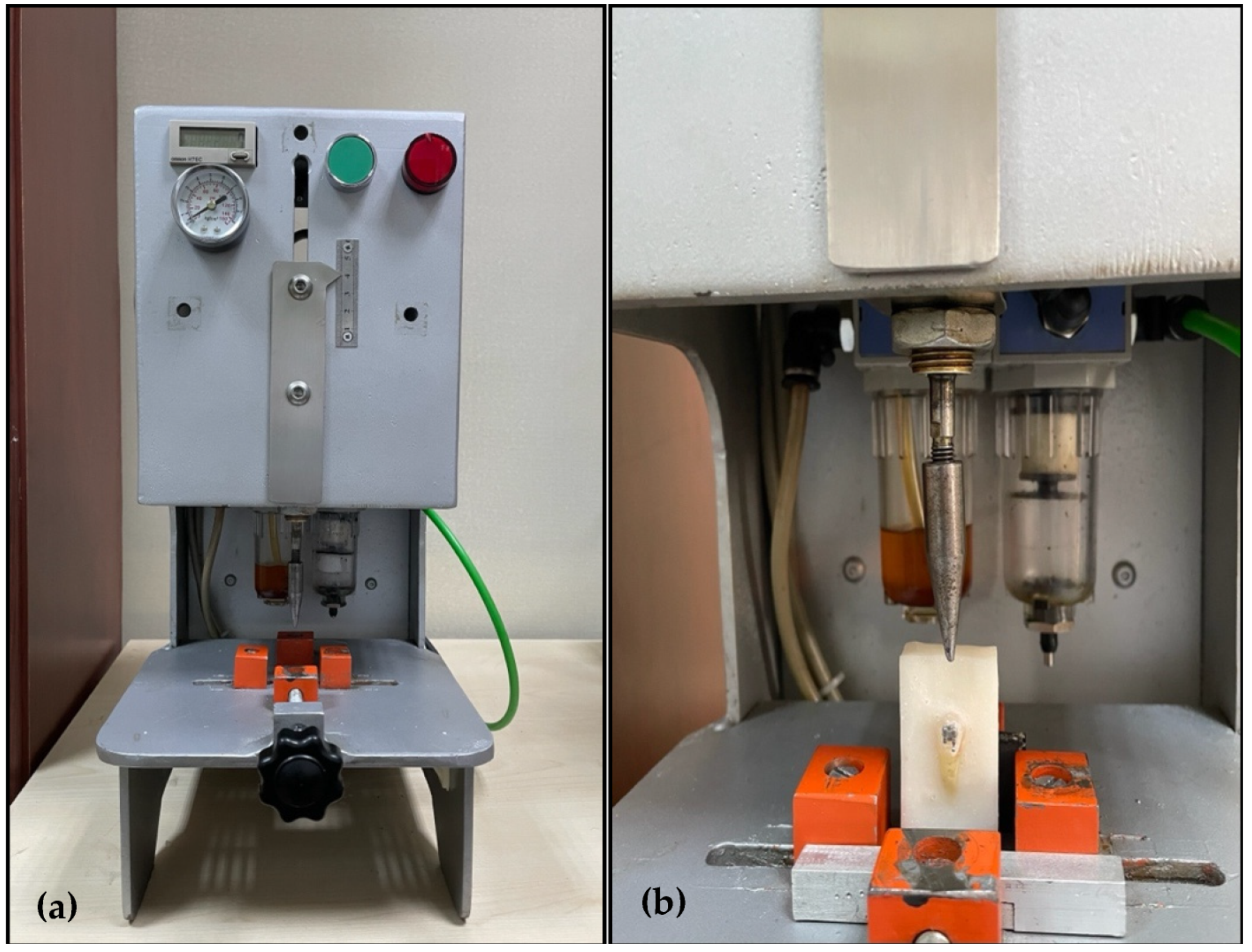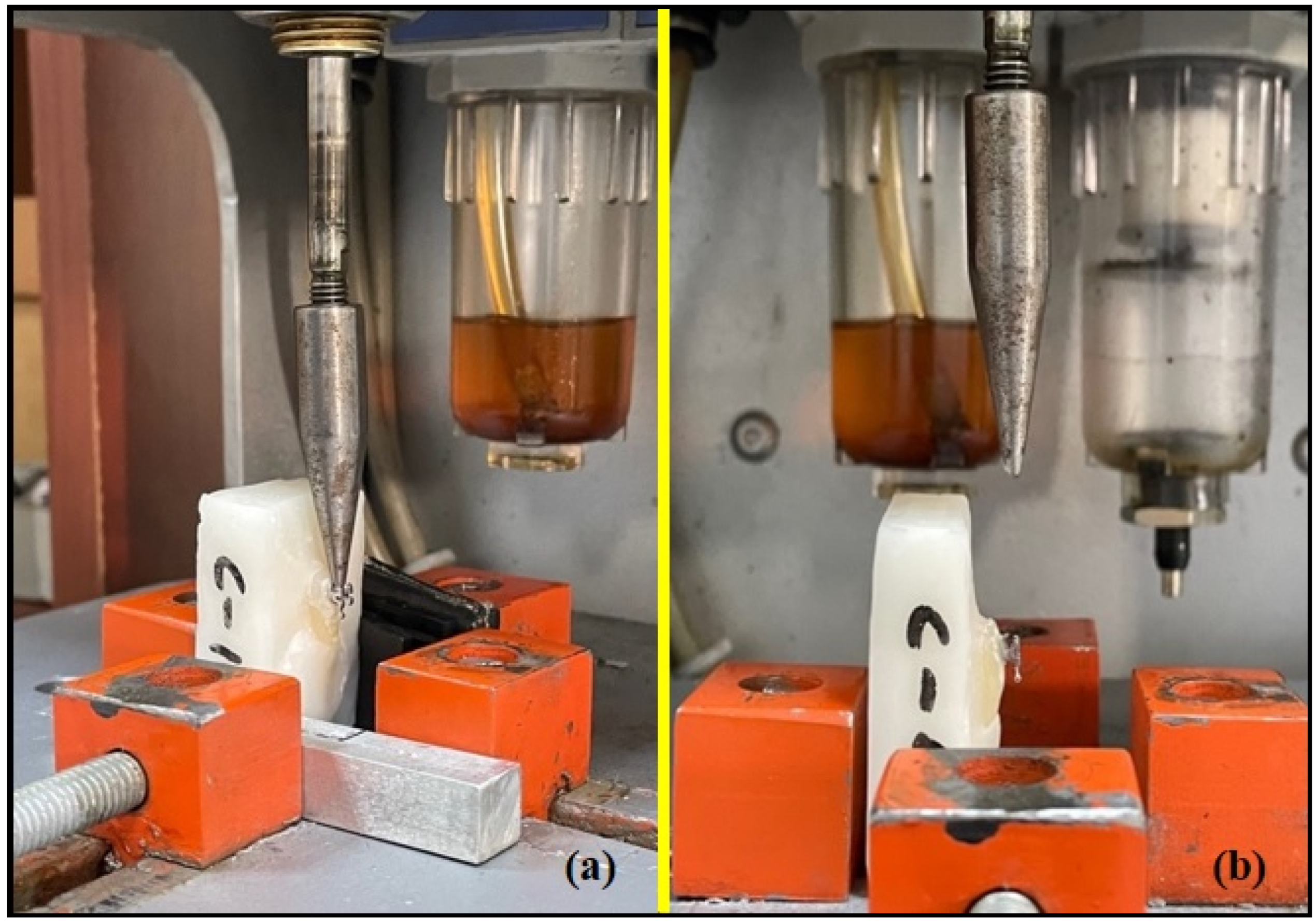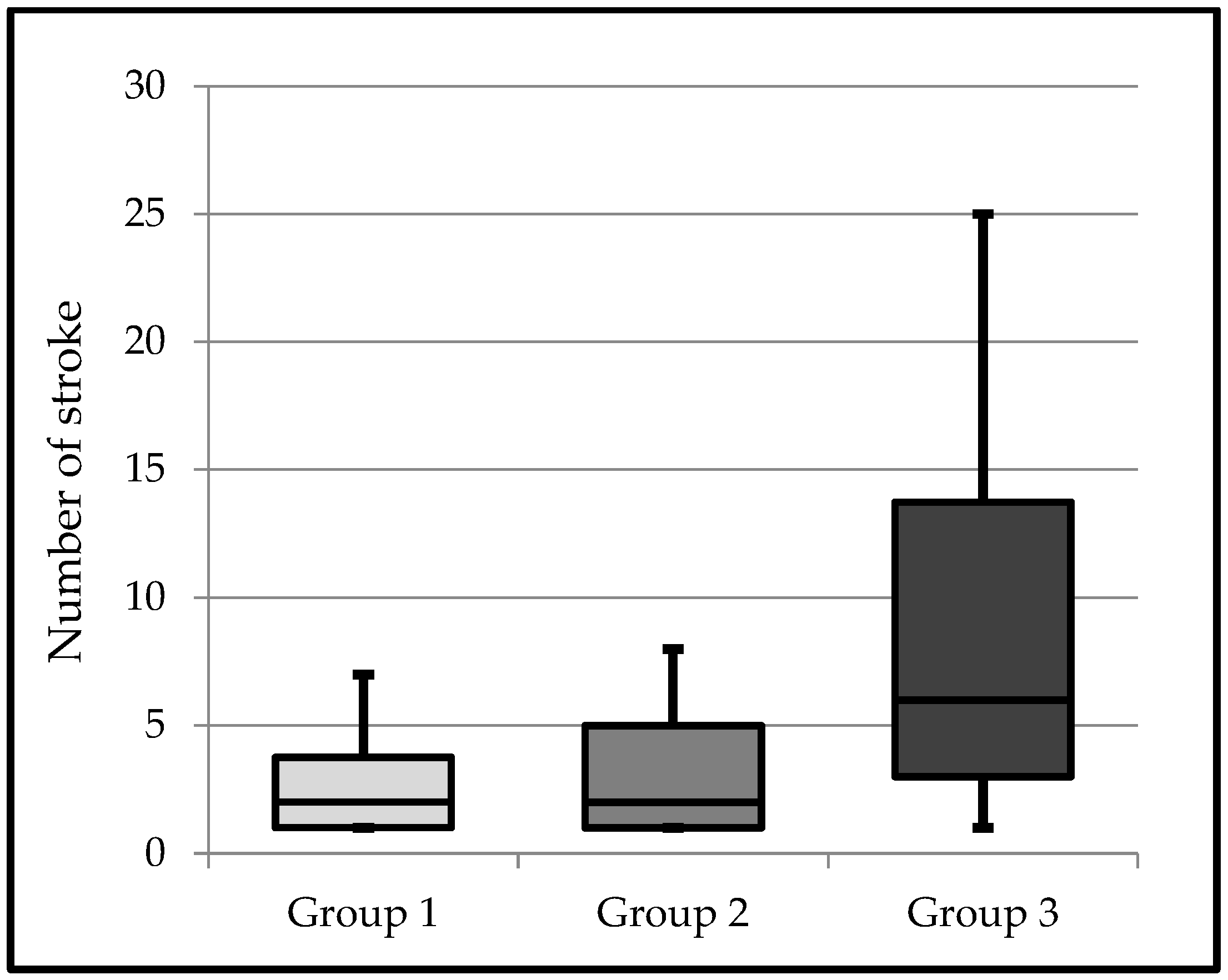Effect of Different Types of Adhesive Agents on Orthodontic Bracket Shear Bond Strength: A Cyclic Loading Study
Abstract
1. Introduction
2. Materials and Methods
2.1. Ethical Approval and Teeth Used in the Study
2.2. Storage Conditions of Teeth
2.3. Preparation of Acrylic Blocks and Embedding of Teeth
2.4. Brackets Used in the Study
2.5. Adhesive Agents Used in the Study
2.6. Bonding of Brackets
2.7. Performing Shear Bond Strength Tests
2.8. Statistical Analysis
3. Results
4. Discussion
5. Conclusions
- i.
- Different types of adhesive agents affect the shear bond strengths of brackets;
- ii.
- Grengloo™ adhesive can be preferable in situations where high bond strength is required, as it shows a significantly higher number of shear strokes than the Transbond™ XT Light Cure Adhesive Paste and BracePaste® adhesives;
- iii.
- BracePaste® adhesive and Transbond™ XT Light Cure Adhesive Paste can be used clinically as alternatives to each other because they exhibit similar numbers of shear strokes;
- iv.
- Considering the limitations of the study, it may seem that there is a need for further in vivo studies.
Author Contributions
Funding
Institutional Review Board Statement
Informed Consent Statement
Data Availability Statement
Acknowledgments
Conflicts of Interest
References
- Çiçek, O.; Özkalaycı, N. Orthodontic Brackets; Part II. J. Int. Dent. Sci. 2018, 4, 134–140. [Google Scholar] [CrossRef]
- Gange, P. The Evolution of Bonding in Orthodontics. Am. J. Orthod. Dentofac. Orthop. 2015, 147, S56–S63. [Google Scholar] [CrossRef] [PubMed]
- Buonocore, M.G. A Simple Method of Increasing the Adhesion of Acrylic Filling Materials to Enamel Surfaces. J. Dent. Res. 1955, 34, 849–853. [Google Scholar] [CrossRef] [PubMed]
- Newman, G.V. Epoxy Adhesives for Orthodontic Attachments: Progress Report. Am. J. Orthod. 1965, 51, 901–912. [Google Scholar] [CrossRef]
- Bakhadher, W.; Halawany, H.; Talic, N.; Abraham, N.; Jacob, V. Factors Affecting the Shear Bond Strength of Orthodontic Brackets—A Review of In Vitro Studies. Acta Med. (Hradec Kral.) 2015, 58, 43–48. [Google Scholar] [CrossRef] [PubMed]
- Alzainal, A.H.; Majud, A.S.; Al-Ani, A.M.; Mageet, A.O. Orthodontic Bonding: Review of the Literature. Int. J. Dent. 2020, 2020, 8874909. [Google Scholar] [CrossRef]
- Khan, H.; Mheissen, S.; Iqbal, A.; Jafri, A.R.; Alam, M.K. Bracket Failure in Orthodontic Patients: The Incidence and the Influence of Different Factors. BioMed Res. Int. 2022, 2022, 5128870. [Google Scholar] [CrossRef]
- Prasad, M.; Mohamed, S.; Nayak, K.; Shetty, S.K.; Talapaneni, A.K. Effect of Moisture, Saliva, and Blood Contamination on the Shear Bond Strength of Brackets Bonded with a Conventional Bonding System and Self-Etched Bonding System. J. Nat. Sci. Biol. Med. 2014, 5, 123–129. [Google Scholar] [CrossRef]
- Türköz, Ç.; Ulusoy, Ç. Evaluation of Different Enamel Conditioning Techniques for Orthodontic Bonding. Korean J. Orthod. 2012, 42, 32–38. [Google Scholar] [CrossRef]
- Pickett, K.L.; Sadowsky, P.L.; Jacobson, A.; Lacefield, W. Orthodontic in Vivo Bond Strength: Comparison with in Vitro Results. Angle Orthod. 2001, 71, 141–148. [Google Scholar] [CrossRef]
- Trakinienė, G.; Petravičiūtė, G.; Smailienė, D.; Narbutaitė, J.; Armalaitė, J.; Lopatienė, K.; Šidlauskas, A.; Trakinis, T. Impact of Fluorosis on the Tensile Bond Strength of Metal Brackets and the Prevalence of Enamel Microcracks. Sci. Rep. 2019, 9, 5957. [Google Scholar] [CrossRef] [PubMed]
- Reynolds, I.R. A Review of Direct Orthodontic Bonding. Br. J. Orthod. 1975, 2, 171–178. [Google Scholar] [CrossRef]
- Lyons, L.K.; English, J.D.; Ontiveros, J.C.; Bussa Jr, H.I.; Harris, L.M.; Laman, S.; Kasper, F.K. In Vitro Shear Testing of Orthodontic Bonding to Lithium Disilicate Ceramic. J. Cosmet. Dent. 2019, 35, 82–89. [Google Scholar]
- Su, M.; Lai, E.H.-H.; Chang, J.Z.-C.; Chen, H.-J.; Chang, F.H.-F.; Chiang, Y.-C.; Lin, C.-P. Effect of Simulated Debracketing on Enamel Damage. J. Formos. Med. Assoc. 2012, 111, 560–566. [Google Scholar] [CrossRef]
- Brown, K. The Impact of Bonding Material on Bracket Failure. Vital 2009, 6, 28–30. [Google Scholar] [CrossRef]
- Almosa, N.; Zafar, H. Incidence of Orthodontic Brackets Detachment during Orthodontic Treatment: A Systematic Review. Pak. J. Med. Sci. 2018, 34, 744–750. [Google Scholar] [CrossRef]
- Menini, A.; Cozzani, M.; Sfondrini, M.F.; Scribante, A.; Cozzani, P.; Gandini, P. A 15-Month Evaluation of Bond Failures of Orthodontic Brackets Bonded with Direct versus Indirect Bonding Technique: A Clinical Trial. Prog. Orthod. 2014, 15, 70. [Google Scholar] [CrossRef]
- Sukhia, R.H.; Sukhia, H.R.; Azam, S.I.; Nuruddin, R.; Rizwan, A.; Jalal, S. Predicting the Bracket Bond Failure Rate in Orthodontic Patients: A Retrospective Cohort Study. Int. Orthod. 2019, 17, 208–215. [Google Scholar] [CrossRef]
- Elsaka, S.E.; Hammad, S.M.; Ibrahim, N.F. Evaluation of Stresses Developed in Different Bracket-Cement-Enamel Systems Using Finite Element Analysis with in Vitro Bond Strength Tests. Prog. Orthod. 2014, 15, 33. [Google Scholar] [CrossRef]
- Eliades, T.; Brantley, W.A. The Inappropriateness of Conventional Orthodontic Bond Strength Assessment Protocols. Eur. J. Orthod. 2000, 22, 13–23. [Google Scholar] [CrossRef]
- Sha, H.N.; Choi, S.H.; Yu, H.S.; Hwang, C.J.; Cha, J.Y.; Kim, K.M. Debonding Force and Shear Bond Strength of an Array of CAD/CAM-Based Customized Orthodontic Brackets, Placed by Indirect Bonding- an in Vitro Study. PLoS ONE 2018, 13, e0202952. [Google Scholar] [CrossRef] [PubMed]
- Farret, M.M.; Gonçalves, T.S.; de Lima, E.M.S.; de Menezes, L.M.; Oshima, H.M.S.; Kochenborger, R.; Mota Freitas, M.P. The Influence of the Methodological Variables on the Shear Bond Strength. Dent. Press J. Orthod. 2010, 15, 80–88. [Google Scholar] [CrossRef]
- Cicek, O.; Ozkalayci, N.; Yetmez, M. Mean Shearing Stroke Frequency of Orthodontic Brackets under Cycling Loading: An In Vitro Study. Materials 2020, 13, 4280. [Google Scholar] [CrossRef] [PubMed]
- Oz, A.A.; Oz, A.Z.; Arici, S. In-Vitro Bond Strengths and Clinical Failure Rates of Metal Brackets Bonded with Different Light-Emitting Diode Units and Curing Times. Am. J. Orthod. Dentofac. Orthop. 2016, 149, 212–216. [Google Scholar] [CrossRef]
- Ansari, M.Y.; Agarwal, D.K.; Gupta, A.; Bhattacharya, P.; Ansar, J.; Bhandari, R. Shear Bond Strength of Ceramic Brackets with Different Base Designs: Comparative in-Vitro Study. J. Clin. Diagn. Res. 2016, 10, ZC64–ZC68. [Google Scholar] [CrossRef]
- Sharma, S.; Tandon, P.; Nagar, A.; Singh, G.P.; Singh, A.; Chugh, V.K. A Comparison of Shear Bond Strength of Orthodontic Brackets Bonded with Four Different Orthodontic Adhesives. J. Orthod. Sci. 2014, 3, 29–33. [Google Scholar] [CrossRef]
- González-Serrano, C.; Baena, E.; Fuentes, M.V.; Albaladejo, A.; Míguez-Contreras, M.; Lagravère, M.O.; Ceballos, L. Shear Bond Strength of a Flash-Free Orthodontic Adhesive System after Thermal Aging Procedure. J. Clin. Exp. Dent. 2019, 11, e154–e161. [Google Scholar] [CrossRef]
- Franz, A.; Raabe, M.; Lilaj, B.; Dauti, R.; Moritz, A.; Müßig, D.; Cvikl, B. Effect of Two Different Primers on the Shear Bond Strength of Metallic Brackets to Zirconia Ceramic. BMC Oral Health 2019, 19, 51. [Google Scholar] [CrossRef]
- Schauseil, M.; Blöcher, S.; Hellak, A.; Roggendorf, M.J.; Stein, S.; Korbmacher-Steiner, H. Shear Bond Strength and Debonding Characteristics of a New Premixed Self-Etching with a Reference Total-Etch Adhesive. Head Face Med. 2016, 12, 4–9. [Google Scholar] [CrossRef]
- Mehta, A.S.; Evans, C.A.; Viana, G.; Bedran-Russo, A.; Galang-Boquiren, M.T.S. Bonding of Metal Orthodontic Attachments to Sandblasted Porcelain and Zirconia Surfaces. BioMed Res. Int. 2016, 2016, 5762785. [Google Scholar] [CrossRef]
- Pham, D.; Bollu, P.; Chaudhry, K.; Subramani, K. Comparative Evaluation of Orthodontic Bracket Base Shapes on Shear Bond Strength and Adhesive Remnant Index: An in Vitro Study. J. Clin. Exp. Dent. 2017, 9, e848–e854. [Google Scholar] [CrossRef] [PubMed]
- Kwak, J.-Y.; Jung, H.-K.; Choi, I.-K.; Kwon, T.-Y. Orthodontic Bracket Bonding to Glazed Full-Contour Zirconia. Restor. Dent. Endod. 2016, 41, 106. [Google Scholar] [CrossRef]
- Al-Nafori, M.K.; Elshal, M.G.; Refai, W.M. The Effect of Incorporating Gold and Silver Nanoparticles in Orthodontic Adhesive System on Bond Strength of Orthodontic Bracket. EC Dent. Sci. 2017, 11, 119–131. [Google Scholar]
- Khanal, P.P.; Shrestha, B.K.; Yadav, R.; Gupta, S.P. A Comparative Study on the Effect of Different Methods of Recycling Orthodontic Brackets on Shear Bond Strength. Int. J. Dent. 2021, 2021, 8844085. [Google Scholar] [CrossRef] [PubMed]
- Dias, F.M.C.S.; Pinzan-Vercelino, C.R.M.; de Tavares, R.R.J.; de Gurgel, J.A.; Bramante, F.S.; Fialho, M.N.P. Evaluation of an Alternative Technique to Optimize Direct Bonding of Orthodontic Brackets to Temporary Crowns. Dent. Press J. Orthod. 2015, 20, 57–62. [Google Scholar] [CrossRef] [PubMed]
- Goymen, M.; Topcuoglu, T.; Topcuoglu, S.; Akin, H. Effect of Different Temporary Crown Materials and Surface Roughening Methods on the Shear Bond Strengths of Orthodontic Brackets. Photomed. Laser Surg. 2015, 33, 55–60. [Google Scholar] [CrossRef] [PubMed]
- Pinho, M.M.; Manso, M.C.; Martin, C.; Souza, J.C.M.; Almeida, R.F.; Ferreira, A.P. Adhesion Strength of Orthodontic Brackets to Acrylic Surfaces. A Systematic Review on in Vitro Studies. Rev. Port. Estomatol. Med. Dent. Cir. Maxilofac. 2017, 58, 65–70. [Google Scholar] [CrossRef]
- Klocke, A.; Kahl-Nieke, B. Influence of Cross-Head Speed in Orthodontic Bond Strength Testing. Dent. Mater. 2005, 21, 139–144. [Google Scholar] [CrossRef]
- Mohammadi, A.; Pourkhameneh, S.; Sadrhaghighi, A.H. The Effect of Different Force Magnitudes for Placement of Orthodontic Brackets on Shear Bond Strength, in Three Adhesive Systems. J. Clin. Exp. Dent. 2018, 10, e548–e554. [Google Scholar] [CrossRef]
- Shaik, J.A.; Reddy, R.K.; Bhagyalakshmi, K.; Shah, M.J.; Madhavi, O.; Ramesh, S.V. In Vitro Evaluation of Shear Bond Strength of Orthodontic Brackets Bonded with Different Adhesives. Contemp. Clin. Dent. 2018, 9, 289–292. [Google Scholar] [CrossRef]
- Klocke, A.; Kahl-Nieke, B. Effect of Debonding Force Direction on Orthodontic Shear Bond Strength. Am. J. Orthod. Dentofac. Orthop. 2006, 129, 261–265. [Google Scholar] [CrossRef] [PubMed]
- Rameez, M.; Kiran, H.; Alle, R.S.; Bharathi, V.S.; Dharmesh, H.S. Comparison of SBS of Colour Changing Adhesives-Transbond Plus, Blugloo, Grengloo. J. Adv. Med. Dent. Sci. Res. 2020, 8, 1–8. [Google Scholar] [CrossRef]
- Priya, B.; Jain, R.K. Comparison of Shear Bond Strength of Different Light Cure Orthodontic Adhesives—An In Vitro Study. Res. J. Pharm. Technol. 2018, 11, 5593–5598. [Google Scholar] [CrossRef]
- Knaup, I.; Böddeker, A.; Tempel, K.; Weber, E.; Bartz, J.R.; Rückbeil, M.V.; Craveiro, R.B.; Wagner, Y.; Wolf, M. Analysing the Potential of Hydrophilic Adhesive Systems to Optimise Orthodontic Bracket Rebonding. Head Face Med. 2020, 16, 20. [Google Scholar] [CrossRef]
- Stefański, T.; Kloc-Ptaszna, A.; Postek-Stefańska, L. Bond Strength of Orthodontic Adhesives to Dry and Saliva-Moistened Enamel—A Comparative in Vitro Study. Arch. Mater. Sci. Eng. 2019, 96, 79–84. [Google Scholar] [CrossRef]
- Nimcharoensuk, K.; Anuwongnukroh, N.; Dechkunakorn, S. Shear Bond Strength of Three Light-Cured Orthodontic Adhesives. Key Eng. Mater. 2018, 777, 587–591. [Google Scholar] [CrossRef]
- Delavarian, M.; Rahimi, F.; Mohammadi, R.; Imani, M. Shear Bond Strength of Ceramic and Metal Brackets Bonded to Enamel Using Color-Change Adhesive. Dent. Res. J. 2019, 16, 233–238. [Google Scholar] [CrossRef]
- Bayani, S.; Ghassemi, A.; Manafi, S.; Delavarian, M. Shear Bond Strength of Orthodontic Color-Change Adhesives with Different Light-Curing Times. Dent. Res. J. 2015, 12, 265–270. [Google Scholar]
- Katırcıoğlu, A.; Büyükbayraktar, Z. Evaluation of the Shear Bond Strength of Light-Cured and Self-Cured Orthodontic Adhesives. Orthod. Forum 2022, 18, 18–23. [Google Scholar] [CrossRef]
- Shams, S.; Abela, S.; Andiappan, M.; Hajiheshmati, A.; Bister, D. Shear Bond Strengths of 3 Commonly Used Orthodontic Adhesives. Dentistry 2020, 10, 8–13. [Google Scholar] [CrossRef]
- Fox, N.A.; McCabe, J.F.; Buckley, J.G. A Critique of Bond Strength Testing in Orthodontics. Br. J. Orthod. 1994, 21, 33–43. [Google Scholar] [CrossRef] [PubMed]
- Szalewski, L.; Wójcik, D.; Sofińska-Chmiel, W.; Kuśmierz, M.; Różyło-Kalinowska, I. How the Duration and Mode of Photopolymerization Affect the Mechanical Properties of a Dental Composite Resin. Materials 2023, 16, 113. [Google Scholar] [CrossRef] [PubMed]
- Szalewski, L.; Wójcik, D.; Bogucki, M.; Szkutnik, J.; Różyło-Kalinowska, I. The Influence of Popular Beverages on Mechanical Properties of Composite Resins. Materials 2021, 14, 3097. [Google Scholar] [CrossRef] [PubMed]




| Groups | Manufacturer | Adhesive Agents | Composition of Adhesive Agent | wt% |
|---|---|---|---|---|
| Group 1 | 3M Unitek, Monrovia, CA, USA | Transbond™ XT Primer | Bisphenol A Diglycidly Ether Dimethacrylate (BİSGMA) | 45–55 |
| Triethylene Glycol Dimethacrylate (TEGDMA) | 45–55 | |||
| 4-(Dimethylamino)-Benzeneethanol | <0.5 | |||
| 3M Unitek, Monrovia, CA, USA | Transbond™ XT Light Cure Adhesive | Silane Treated Quartz | 70–80 | |
| Bisphenol A Diglycidyl Ether Dimethacrylate (BİSGMA) | 10–20 | |||
| Bisphenol A Dimethacrylate | 5–10 | |||
| Silane Treated Silica | <2 | |||
| Diphenyliodonium Hexafluorophosphate | <1 | |||
| Triphenylantimony | <1 | |||
| Group 2 | American Orthodontics, Sheboygan, WI, USA | BracePaste® MTP Primer | Ethanol | 20–50 |
| 2-Hydroxyethyl methacrylate | 10–25 | |||
| 2-Hydroxy-1,3-propanediyl bismethacrylate | 2.5–10 | |||
| American Orthodontics, Sheboygan, WI, USA | BracePaste® Adhesive | Ethoxylated Bisphenol A Dimethacrylate | 2.5–12 | |
| Tetramethylene Dimethacrylate | <3 | |||
| Diphenyl(2,4,6-trimethylbenzoyl)phosphine oxide | <3 | |||
| Group 3 | Ormco, Orange, CA, USA | Ortho Solo™ Primer | 2-Hydroxyethyl methacrylate | 30–60 |
| 2-Hydroxy-1,3-propanediyl bismethacrylate | 5–10 | |||
| Ethanol | 1–5 | |||
| 3-Trimethoxysilylpropyl methacrylate | 1–5 | |||
| Disodium hexafluorosilicate | 0.1–1 | |||
| Ormco, Glendora, CA, USA | Grengloo™ Adhesive | Bisphenol A ethoxylate dimethacrylate | ≤2.9 | |
| Silica, amorphous, fumed, and cryst.-free | ≤1.9 | |||
| 2,3-Epoxypropyl methacrylate | <1 | |||
| Propylidynetrimethanol, ethoxylated, esters with acrylic acid | <1 | |||
| 7,7,9 (or 7,9,9)-Trimethyl-4,13-dioxo-3,14-dioxa-5,12-diazahexadecane-1,16-diyl bismethacrylate | <1 | |||
| Phenyl bis (2,4,6-trimethylbenzoyl)-phosphine oxide | <1 | |||
| Bisphenol A | ≤0.3 |
| Test Group | Sample | Mean Number of Strokes | Median | Standard Deviation | Min | Max | p |
|---|---|---|---|---|---|---|---|
| Group 1 | 20 | 2.8 | 2 | 1.8 | 1.0 | 7.0 | |
| Group 2 | 20 | 3.1 | 2 | 2.3 | 1.0 | 8.0 | 0.002 * |
| Group 3 | 20 | 8.4 | 6 | 6.9 | 1.0 | 25.0 |
| Groups | N | Mean Rank | Sum of Ranks | p a |
|---|---|---|---|---|
| Group 1 | 20 | 20.48 | 409.50 | 0.989 |
| Group 2 | 20 | 20.53 | 410.50 | |
| Total | 40 | |||
| Group 1 | 20 | 14.78 | 295.50 | 0.002 * |
| Group 3 | 20 | 26.23 | 524.50 | |
| Total | 40 | |||
| Group 2 | 20 | 15.03 | 300.50 | 0.003 * |
| Group 3 | 20 | 25.98 | 519.50 | |
| Total | 40 |
Disclaimer/Publisher’s Note: The statements, opinions and data contained in all publications are solely those of the individual author(s) and contributor(s) and not of MDPI and/or the editor(s). MDPI and/or the editor(s) disclaim responsibility for any injury to people or property resulting from any ideas, methods, instructions or products referred to in the content. |
© 2023 by the authors. Licensee MDPI, Basel, Switzerland. This article is an open access article distributed under the terms and conditions of the Creative Commons Attribution (CC BY) license (https://creativecommons.org/licenses/by/4.0/).
Share and Cite
Eser, I.; Cicek, O.; Ozkalayci, N.; Yetmez, M.; Erener, H. Effect of Different Types of Adhesive Agents on Orthodontic Bracket Shear Bond Strength: A Cyclic Loading Study. Materials 2023, 16, 724. https://doi.org/10.3390/ma16020724
Eser I, Cicek O, Ozkalayci N, Yetmez M, Erener H. Effect of Different Types of Adhesive Agents on Orthodontic Bracket Shear Bond Strength: A Cyclic Loading Study. Materials. 2023; 16(2):724. https://doi.org/10.3390/ma16020724
Chicago/Turabian StyleEser, Irfan, Orhan Cicek, Nurhat Ozkalayci, Mehmet Yetmez, and Hande Erener. 2023. "Effect of Different Types of Adhesive Agents on Orthodontic Bracket Shear Bond Strength: A Cyclic Loading Study" Materials 16, no. 2: 724. https://doi.org/10.3390/ma16020724
APA StyleEser, I., Cicek, O., Ozkalayci, N., Yetmez, M., & Erener, H. (2023). Effect of Different Types of Adhesive Agents on Orthodontic Bracket Shear Bond Strength: A Cyclic Loading Study. Materials, 16(2), 724. https://doi.org/10.3390/ma16020724








